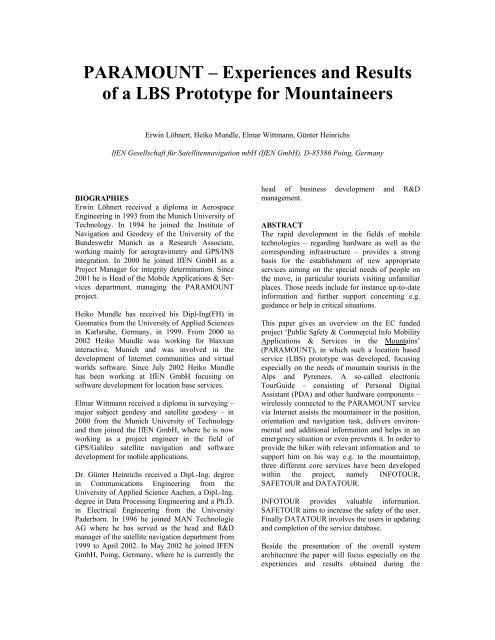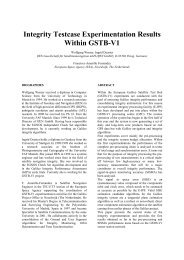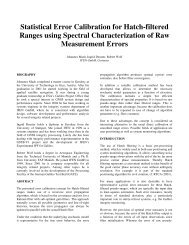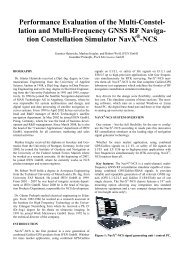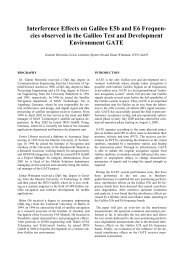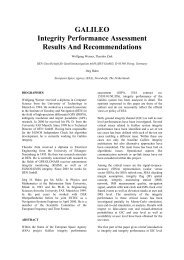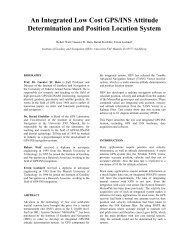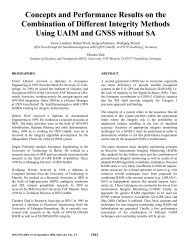PARAMOUNT – Experiences and Results of a LBS Prototype ... - IFEN
PARAMOUNT – Experiences and Results of a LBS Prototype ... - IFEN
PARAMOUNT – Experiences and Results of a LBS Prototype ... - IFEN
You also want an ePaper? Increase the reach of your titles
YUMPU automatically turns print PDFs into web optimized ePapers that Google loves.
<strong>PARAMOUNT</strong> <strong>–</strong> <strong>Experiences</strong> <strong>and</strong> <strong>Results</strong><br />
<strong>of</strong> a <strong>LBS</strong> <strong>Prototype</strong> for Mountaineers<br />
Erwin Löhnert, Heiko Mundle, Elmar Wittmann, Günter Heinrichs<br />
IfEN Gesellschaft für Satellitennavigation mbH (IfEN GmbH), D-85586 Poing, Germany<br />
BIOGRAPHIES<br />
Erwin Löhnert received a diploma in Aerospace<br />
Engineering in 1993 from the Munich University <strong>of</strong><br />
Technology. In 1994 he joined the Institute <strong>of</strong><br />
Navigation <strong>and</strong> Geodesy <strong>of</strong> the University <strong>of</strong> the<br />
Bundeswehr Munich as a Research Associate,<br />
working mainly for aerogravimetry <strong>and</strong> GPS/INS<br />
integration. In 2000 he joined IfEN GmbH as a<br />
Project Manager for integrity determination. Since<br />
2001 he is Head <strong>of</strong> the Mobile Applications & Services<br />
department, managing the <strong>PARAMOUNT</strong><br />
project.<br />
Heiko Mundle has received his Dipl-Ing(FH) in<br />
Geomatics from the University <strong>of</strong> Applied Sciences<br />
in Karlsruhe, Germany, in 1999. From 2000 to<br />
2002 Heiko Mundle was working for blaxxun<br />
interactive, Munich <strong>and</strong> was involved in the<br />
development <strong>of</strong> Internet communities <strong>and</strong> virtual<br />
worlds s<strong>of</strong>tware. Since July 2002 Heiko Mundle<br />
has been working at IfEN GmbH focusing on<br />
s<strong>of</strong>tware development for location base services.<br />
Elmar Wittmann received a diploma in surveying <strong>–</strong><br />
major subject geodesy <strong>and</strong> satellite geodesy <strong>–</strong> in<br />
2000 from the Munich University <strong>of</strong> Technology<br />
<strong>and</strong> then joined the IfEN GmbH, where he is now<br />
working as a project engineer in the field <strong>of</strong><br />
GPS/Galileo satellite navigation <strong>and</strong> s<strong>of</strong>tware<br />
development for mobile applications.<br />
Dr. Günter Heinrichs received a Dipl.-Ing. degree<br />
in Communications Engineering from the<br />
University <strong>of</strong> Applied Science Aachen, a Dipl.-Ing.<br />
degree in Data Processing Engineering <strong>and</strong> a Ph.D.<br />
in Electrical Engineering from the University<br />
Paderborn. In 1996 he joined MAN Technologie<br />
AG where he has served as the head <strong>and</strong> R&D<br />
manager <strong>of</strong> the satellite navigation department from<br />
1999 to April 2002. In May 2002 he joined <strong>IFEN</strong><br />
GmbH, Poing, Germany, where he is currently the<br />
head <strong>of</strong> business development <strong>and</strong> R&D<br />
management.<br />
ABSTRACT<br />
The rapid development in the fields <strong>of</strong> mobile<br />
technologies <strong>–</strong> regarding hardware as well as the<br />
corresponding infrastructure <strong>–</strong> provides a strong<br />
basis for the establishment <strong>of</strong> new appropriate<br />
services aiming on the special needs <strong>of</strong> people on<br />
the move, in particular tourists visiting unfamiliar<br />
places. Those needs include for instance up-to-date<br />
information <strong>and</strong> further support concerning e.g.<br />
guidance or help in critical situations.<br />
This paper gives an overview on the EC funded<br />
project ‘Public Safety & Commercial Info Mobility<br />
Applications & Services in the Mountains’<br />
(<strong>PARAMOUNT</strong>), in which such a location based<br />
service (<strong>LBS</strong>) prototype was developed, focusing<br />
especially on the needs <strong>of</strong> mountain tourists in the<br />
Alps <strong>and</strong> Pyrenees. A so-called electronic<br />
TourGuide <strong>–</strong> consisting <strong>of</strong> Personal Digital<br />
Assistant (PDA) <strong>and</strong> other hardware components <strong>–</strong><br />
wirelessly connected to the <strong>PARAMOUNT</strong> service<br />
via Internet assists the mountaineer in the position,<br />
orientation <strong>and</strong> navigation task, delivers environmental<br />
<strong>and</strong> additional information <strong>and</strong> helps in an<br />
emergency situation or even prevents it. In order to<br />
provide the hiker with relevant information <strong>and</strong> to<br />
support him on his way e.g. to the mountaintop,<br />
three different core services have been developed<br />
within the project, namely INFOTOUR,<br />
SAFETOUR <strong>and</strong> DATATOUR.<br />
INFOTOUR provides valuable information.<br />
SAFETOUR aims to increase the safety <strong>of</strong> the user.<br />
Finally DATATOUR involves the users in updating<br />
<strong>and</strong> completion <strong>of</strong> the service database.<br />
Beside the presentation <strong>of</strong> the overall system<br />
architecture the paper will focus especially on the<br />
experiences <strong>and</strong> results obtained during the
project’s test <strong>and</strong> demonstration phase <strong>of</strong> the<br />
prototype service in a regional test area <strong>of</strong> the<br />
Bavarian Alps.<br />
INTRODUCTION<br />
<strong>PARAMOUNT</strong> is a mobile navigation <strong>and</strong><br />
information system prototype. It has been designed<br />
focussing especially on the needs <strong>of</strong> hikers <strong>and</strong><br />
w<strong>and</strong>erers on the one h<strong>and</strong> <strong>and</strong> the mountain rescue<br />
services on the other h<strong>and</strong>. This includes also a<br />
support tool for controlling <strong>and</strong> coordinating the<br />
SAR (Search-<strong>and</strong>-Rescue) missions <strong>of</strong> the<br />
mountain rescue teams.<br />
The prototype is funded by the European Commission<br />
<strong>and</strong> has been developed by an international<br />
consortium <strong>of</strong> 5 partners. The project has started in<br />
02/2002 <strong>and</strong> will be finished in 10/2003.<br />
OBJECTIVES AND MOTIVATION<br />
The project is driven by the motivation to<br />
contribute to the improvement <strong>of</strong> user-friendly<br />
info-mobility services by combining technologies<br />
from the fields <strong>of</strong> satellite navigation,<br />
telecommunications <strong>and</strong> geo-information. This<br />
includes the following main objectives:<br />
Figure 1: <strong>PARAMOUNT</strong> System Overview<br />
- Development <strong>of</strong> a Location Based Service<br />
(<strong>LBS</strong>) prototype providing appropriate information<br />
<strong>and</strong> features for mountain hikers <strong>and</strong><br />
w<strong>and</strong>erers<br />
- Integration <strong>of</strong> support <strong>and</strong> control facilities for<br />
mountain rescue services<br />
- Demonstration <strong>and</strong> pro<strong>of</strong> <strong>of</strong> feasibility <strong>of</strong> such<br />
a combined system especially for mountainous<br />
areas.<br />
THE <strong>PARAMOUNT</strong> SERVICES<br />
The location-based service prototype integrates<br />
positioning, navigation, communication, coordination<br />
<strong>and</strong> information services based on compact<br />
hardware components <strong>and</strong> mobile communication<br />
technology. The service demonstrator shows that<br />
state-<strong>of</strong>-the-art technology can be used to establish<br />
user-friendly services, which can lead to a<br />
significant improvement <strong>of</strong> comfort <strong>and</strong> safety <strong>of</strong><br />
millions <strong>of</strong> people, who are going to the mountains<br />
<strong>of</strong> the Alps <strong>and</strong> Pyrenees.<br />
Three different kinds <strong>of</strong> core services were<br />
developed within <strong>PARAMOUNT</strong> (Figure 1):<br />
INFOTOUR is for guiding, routing <strong>and</strong> informing<br />
the user. It provides fundamental services, which<br />
allow the user to access dedicated information at
home <strong>and</strong> in particular on the mountains. The user<br />
requests maps <strong>of</strong> different scales <strong>and</strong> extent from<br />
the INFOTOUR server. He/she can also ask for so<br />
called points <strong>of</strong> interest <strong>–</strong> touristic relevant destinations,<br />
e.g. summits, public transportation stations,<br />
huts <strong>and</strong> hotels.<br />
After selecting a destination the service determines<br />
the best route. If the user gets lost for example due<br />
to poor weather visibility the user can request the<br />
route back to a trail. If the weather becomes too bad<br />
for walking or if the user is exhausted <strong>and</strong> needs to<br />
rest, the system even finds the route to the nearest<br />
hut. The hiker can choose to be guided along these<br />
routes to find his/her way more easily.<br />
Besides the user will have access to local weather<br />
forecasts as well as common tourist information<br />
depending on his/her position. For more intuitive<br />
view <strong>of</strong> the chosen trail, the user can request from<br />
the server a 3D picture <strong>of</strong> the surrounding hills with<br />
an emphasised trail on it.<br />
The contents are at different dynamic levels. Firstly<br />
long-term data like 3-D geographic data (trails,<br />
height data…) <strong>and</strong> restaurants. Secondly mediumterm<br />
data like local (cultural) events, timetables <strong>and</strong><br />
opening hours <strong>of</strong> mountain huts. Thirdly short-term<br />
data in particular avalanche prediction <strong>and</strong> weather<br />
forecasts. Last but not least instant content. ‘Off-<br />
Board’ routing belongs to that.<br />
Figure 2: Screenshot <strong>of</strong> SAR Centre Client<br />
SAFETOUR provides in addition to the information<br />
described above especially safety relevant data.<br />
The usual mountaineer can send an emergency call<br />
including his/her current position in case <strong>of</strong><br />
emergency. If a hiker becomes witness <strong>of</strong> an<br />
accident he is enabled to send a call <strong>and</strong> define the<br />
position <strong>of</strong> the victim on the map. Furthermore<br />
SAFETOUR tracks mountaineers in critical environments<br />
<strong>and</strong> in dangerous terrain.<br />
For the support <strong>of</strong> the search-<strong>and</strong>-rescue (SAR)<br />
organisations a so-called ’SAR Centre client’ (see<br />
Figure 2) was developed. Using this application a<br />
coordinator in the SAR centre can track the<br />
movements <strong>of</strong> his rescue teams on a map as well as<br />
in a 3D environment <strong>and</strong> access several information<br />
concerning the status <strong>of</strong> the operation.<br />
It's understood that the rescue teams can use all <strong>of</strong><br />
the INFOTOUR features for routing <strong>and</strong> guidance,<br />
as well.<br />
To allow for an efficient <strong>and</strong> appropriate help for<br />
the tourist in case <strong>of</strong> an emergency it is useful for<br />
the rescue people to have some relevant<br />
information on the general state <strong>of</strong> his health, e.g.<br />
an existing cardiac insufficiency or the need for<br />
special medicine. Willing users can store this<br />
information on the server<br />
In the Pyrenees additional to these safety features<br />
avalanche forecasting has been implemented to
give back country skiers more regional <strong>and</strong> up-todate<br />
avalanche hazards. The generation process <strong>of</strong><br />
an avalanche hazard bulletin has been systematized<br />
<strong>and</strong> semi-automated. In-field user observations,<br />
which will be done by many <strong>PARAMOUNT</strong> users,<br />
are used as extra local input data. Above all the<br />
avalanche path maps are integrated with the<br />
temporal information <strong>of</strong> the bulletin. To solve the<br />
geographic interpretation difficulties the bulletin is<br />
represented in easy readable diagrams <strong>and</strong> maps<br />
(see Figure 3). The user can choose to overlay the<br />
avalanche prediction layer onto the topographic<br />
maps.<br />
Figure 3: Avalanche forecasting map<br />
DATATOUR directly involves the <strong>PARAMOUNT</strong><br />
users in the data acquisition <strong>and</strong> maintaining<br />
process. As this is a critical <strong>and</strong> security sensitive<br />
matter this service will only be available to a group<br />
<strong>of</strong> registered users. This group will collect the<br />
following information:<br />
- Logging the used trail to update the trail<br />
network <strong>and</strong> derive new trails<br />
- Information on severity <strong>of</strong> trails (personal<br />
evaluation) to perform a more specific routing<br />
- Capturing/updating information on Points <strong>of</strong><br />
Interest to ensure an up-to-date INFOTOUR<br />
service<br />
The processing <strong>and</strong> verification <strong>of</strong> the collected<br />
data will be performed partly-automatically on<br />
server side. DATATOUR allows reducing the<br />
maintenance costs <strong>of</strong> database necessary for all<br />
other services.<br />
The hiker accesses these services with the mobile<br />
client called TourGuide. Its hardware is based on<br />
common-<strong>of</strong>-the-shelf components in order to allow<br />
for a configuration as flexible as possible. The<br />
basic ‘terminal’ for the TourGuide application is a<br />
Pocket PC with additional modules for the<br />
navigation <strong>and</strong> communication tasks. These modules<br />
can be attached to the Pocket PC or already be<br />
integrated (e.g. a smart phone with integrated communication<br />
module).<br />
Basically the following components are required:<br />
- Pocket PC resp. Pocket PC Phone. Depending<br />
on the model an additional expansion pack<br />
may be necessary for inserting the external<br />
modules<br />
- GPRS communication unit, either already<br />
integrated in the Pocket PC or as separate<br />
device. This can be e.g. a GPRS capable<br />
mobile phone with Bluetooth interface (for a<br />
wireless communication) or a GPRS modem<br />
card to be plugged into the Pocket PC.<br />
- GPS navigation unit<br />
Two <strong>of</strong> the tested arrangements are shown in<br />
Figure 4. The first one is the st<strong>and</strong>ard hardware for<br />
leisure hikers. It consists <strong>of</strong> an iPAQ, a GPRS<br />
modem <strong>and</strong> GPS receiver CompactFlash card. The<br />
second one is designed for pr<strong>of</strong>essional use <strong>of</strong> the<br />
search <strong>and</strong> rescue teams. The small Bluetooth GPS<br />
receiver can be put into a pocket or backpack. The<br />
more robust PDA with integrated GPRS modem is<br />
shock- <strong>and</strong> waterpro<strong>of</strong>.<br />
Figure 4: St<strong>and</strong>ard Hardware (left),<br />
Ruggedised outdoor HW (e.g. for SAR teams)<br />
(right)<br />
The TourGuide application s<strong>of</strong>tware (Figure 5) has<br />
been developed for the Windows CE based Pocket<br />
PC operating system <strong>of</strong> Micros<strong>of</strong>t. All components<br />
have been implemented in C++ using the development<br />
environment Micros<strong>of</strong>t embedded Visual C++<br />
3.0. The Graphical User Interface (GUI) <strong>of</strong> the<br />
application has been designed for three different
user languages: English (original version), German<br />
<strong>and</strong> Spanish.<br />
Figure 5: TourGuide s<strong>of</strong>tware screenshots<br />
RESULTS OF AVAILABILITY ANALYSIS<br />
Since the provision <strong>of</strong> the <strong>PARAMOUNT</strong> services<br />
requires the availability <strong>of</strong> GPS, GSM/GPRS <strong>and</strong><br />
GIS (summarized as G3), investigations <strong>and</strong><br />
simulations for the Alps <strong>and</strong> Pyrenees have been<br />
performed in order to identify potential pilot areas,<br />
where <strong>PARAMOUNT</strong> can be demonstrated. The<br />
GPS availability resp. visibility analysis for the<br />
Alps, using the digital terrain model (DTM)<br />
DTED0 with a grid resolution <strong>of</strong> about 900 m <strong>and</strong> a<br />
computation grid <strong>of</strong> about 2 km resulted in the<br />
Figure 6.<br />
Some more detailed simulations have been<br />
performed on local level for a few particular<br />
‘c<strong>and</strong>idate areas’. Given the used high resolution <strong>of</strong><br />
30 m (for the DTM as well as the computation grid)<br />
the significance <strong>of</strong> the obtained results is<br />
underst<strong>and</strong>ably higher than the less detailed overall<br />
results. The simulation outcomes for the Sudelfeld<br />
area (Bavaria, Germany) that has been finally<br />
selected as the German test area are depicted in<br />
Figure 8. As it can be easily seen from the left h<strong>and</strong><br />
image there are in fact some areas with a limited<br />
availability <strong>of</strong> GPS for certain time due to the<br />
rough terrain. This poor coverage could be<br />
completely remedied with the additional use <strong>of</strong> the<br />
future Galileo system (full operation targeted for<br />
2008) according to the results depicted in the right<br />
h<strong>and</strong> figure.<br />
Figure 7: Test area <strong>of</strong> Sudelfeld (GER)<br />
map <strong>and</strong> terrain model<br />
Figure 8: Minimum number <strong>of</strong> satellites:<br />
Local GPS (left) <strong>and</strong> GPS + Galileo (right)<br />
availability simulations for Sudelfeld area<br />
Figure 6: GPS availability analysis: minimum number <strong>of</strong> GPS satellites visible in the Alps
Figure 9: GSM/GPRS coverage in the Alps (Fig. I) <strong>and</strong> overall ‘G3’ availability (Fig. II)<br />
Summarizing the results <strong>of</strong> the provider-based<br />
GSM/GPRS availability analysis over the whole<br />
areas <strong>of</strong> interest, i.e. the maps/data used are based<br />
on the estimated coverages supplied by the mobile<br />
phone providers, it can be stated that wide parts <strong>of</strong><br />
the mountainous regions <strong>of</strong> Alps <strong>and</strong> Pyrenees are<br />
covered by the mobile radio signals. However,<br />
there are <strong>of</strong> course also a considerable number <strong>of</strong><br />
significant gaps, especially in areas with very rough<br />
terrain (Figure 9). In general the availability is very<br />
well in the valleys <strong>and</strong> along the flanking slopes<br />
<strong>and</strong> is partly decreasing sometimes in more remote<br />
areas in the high mountains.<br />
Especially in areas <strong>of</strong> high touristic relevance the<br />
availability is mainly quite satisfying. Furthermore<br />
many mobile phone providers continue to exp<strong>and</strong><br />
their networks also in the mountainous regions by<br />
installing additional base stations due to the<br />
increased attractiveness <strong>of</strong> this region by people<br />
searching for recreation <strong>and</strong> fun. However, a<br />
complete availability <strong>of</strong> terrestrial GSM signals will<br />
probably never be achieved.<br />
With respect to Figure 9 it has to be noted that the<br />
relatively low overall G3 coverage is due to the fact<br />
that it was assumed that all required GIS data for<br />
<strong>PARAMOUNT</strong> must already be available in digital<br />
form, i.e. trails <strong>and</strong> points <strong>of</strong> interest like huts,<br />
summits etc. This is, <strong>of</strong> course, not the case for<br />
significant portions <strong>of</strong> the Alps (the areas not<br />
shown in green Figure 9/II). However, the GIS<br />
availability investigation performed showed that<br />
the required digital terrain models, vector <strong>and</strong> raster<br />
based data is widely available throughout the Alps<br />
<strong>and</strong> Pyrenees. In order to actually provide the<br />
service, additional data on trails <strong>and</strong> points <strong>of</strong><br />
interest will have to be acquired for certain areas in<br />
the Alps.<br />
FURTHER EXPERIENCE AND TEST<br />
RESULTS<br />
The analysis <strong>of</strong> the GPRS availability showed, that<br />
there are <strong>of</strong> course gaps in remote mountainous<br />
regions. But for areas <strong>of</strong> high touristic relevance<br />
like hiking <strong>and</strong> skiing resorts with a lot <strong>of</strong> visitors<br />
GPRS is available to a large extent. In the test area<br />
Sudelfeld (German Alps) there are only gaps in<br />
very rough terrain. To avoid lack <strong>of</strong> service it has<br />
been necessary to make an effort in the<br />
client/server trade-<strong>of</strong>f.<br />
During the tests a good overall GPS availability<br />
was observed. Problems encountered in very severe<br />
environment like steep canyons or ravines etc.<br />
could be remedied in the future with the additional<br />
use <strong>of</strong> Galileo. The use <strong>of</strong> common-<strong>of</strong>-the-shelf<br />
GPS receiver modules allows to extend a Pocket<br />
PC for a convenient hardware solution. Modules in<br />
Compact Flash format as well as Bluetooth<br />
receivers can be connected easily via COM port<br />
<strong>and</strong> the NMEA interface st<strong>and</strong>ard. GPS heading<br />
values are sufficient at normal hiking speed; the<br />
hiker only needs to walk a few foot steps to receive<br />
a good heading accuracy. Of course the heading<br />
information is not reliable when the hiker stops <strong>and</strong><br />
turns left/right, because then he has a velocity close<br />
to zero. Tests undertaken with an additional digital<br />
compass serially connected to the TourGuide<br />
hardware in fact eliminated this behaviour <strong>and</strong><br />
yielded good results. However, any use <strong>of</strong><br />
additional hardware increases costs <strong>and</strong> decreases<br />
e.g. the run-time <strong>of</strong> the battery. Thus, pros <strong>and</strong> cons<br />
have to be traded-<strong>of</strong>f thoroughly.
The G3 analysis performed showed that the<br />
concurrently availability <strong>of</strong> GPRS, GPS <strong>and</strong> GIS is<br />
quite promising for many areas <strong>of</strong> the Alps <strong>and</strong><br />
Pyrenees, especially in the areas <strong>of</strong> high touristic<br />
relevance.<br />
<strong>PARAMOUNT</strong> was extensively tested in the test<br />
phase between March <strong>and</strong> July <strong>of</strong> 2003. Not only<br />
internal test by the consortium were carried out but<br />
also with interested hikers as well as with SAR<br />
representatives. The external testers embraced the<br />
TourGuide hardware <strong>and</strong> s<strong>of</strong>tware <strong>and</strong> liked the<br />
functionality <strong>and</strong> the compact size <strong>of</strong> the<br />
equipment. During the test phase it was<br />
experienced that the battery capacity is in fact well<br />
sufficient for day trips, however for multiple day<br />
trips it is necessary to recharge the batteries for<br />
each further day.<br />
The SAR members attested that the SAFETOUR<br />
features implemented in <strong>PARAMOUNT</strong> are very<br />
well suited to make SAR missions faster <strong>and</strong> more<br />
effective. Especially the transfer <strong>of</strong> exact position<br />
coordinates <strong>of</strong> the distressed person within the<br />
emergency call message is <strong>of</strong> paramount<br />
importance for the rescue teams. In addition, the<br />
functionality that the position <strong>of</strong> the casualty is not<br />
only shown on the SAR Mission Control s<strong>of</strong>tware<br />
but also appears on the displays <strong>of</strong> the SAR<br />
TourGuides used by the SAR team members,<br />
increases also an effective rescue mission. Finally,<br />
the SAR Mission Control client with its<br />
collaboration functionality <strong>of</strong> coordinating,<br />
controlling <strong>and</strong> communicating to the SAR<br />
TourGuides turned out to be a very valuable <strong>and</strong><br />
helpful tool for supporting emergency missions.<br />
However, we also realized that further efforts are<br />
necessary to improve service robustness <strong>and</strong><br />
reliability. Especially the operation system features<br />
like connecting to the Internet were sometime<br />
tricky to use.<br />
CONCLUSION & PERSPECTIVES<br />
Within the <strong>PARAMOUNT</strong> project a running prototype<br />
<strong>LBS</strong> system for hikers was successfully<br />
established in two particular test areas <strong>of</strong> the<br />
German Alps <strong>and</strong> the Spanish Pyrenees. Following<br />
this prototype phase it is intended to build up a<br />
regular <strong>PARAMOUNT</strong> pilot service in a dedicated<br />
tourist area in the Alpine region.<br />
Regarding the SAFETOUR functionality a transfer<br />
to applications for other public areas, such as fire<br />
brigade, police etc., is also well considered.<br />
Further information on the project can also be<br />
found on the <strong>of</strong>ficial project web page:<br />
www.paramount-tours.com.<br />
ACKNOWLEDGMENTS<br />
The <strong>PARAMOUNT</strong> consortium gratefully<br />
acknowledges the funding <strong>of</strong> the project by the<br />
European Commission (within the IST programme,<br />
CPA3).<br />
The project consortium includes 5 partners from<br />
Germany, Austria <strong>and</strong> Spain:<br />
IfEN GmbH is a privately owned company, which<br />
is strongly involved in satellite navigation system<br />
studies related to GNSS including GNSS research<br />
<strong>and</strong> development. In recent time, IfEN GmbH is<br />
also engaged in mobile applications <strong>and</strong> <strong>LBS</strong>. IfEN<br />
GmbH acts as the project coordinator.<br />
AGIS (Arbeitsgemeinschaft GIS) <strong>of</strong> the University<br />
<strong>of</strong> the Bundeswehr Munich is a study group<br />
focused on research <strong>and</strong> development activities in<br />
the fields <strong>of</strong> geoinformation systems.<br />
ICC (Institut Cartografic de Catalunya, Barcelona,<br />
Spain) is an entity <strong>of</strong> public jurisdiction <strong>of</strong> the<br />
Generalitat de Catalunya <strong>and</strong> produces <strong>and</strong><br />
distributes cartographic/geodetic data.<br />
Especially for the definition <strong>of</strong> the user requirements<br />
<strong>and</strong> the system test the following two<br />
organisations have been involved in the project: the<br />
Bavarian Mountain SAR Service (Bergwacht<br />
Bayern) <strong>and</strong> the Austrian Mountain SAR Service<br />
(OEBRD).<br />
REFERENCES<br />
[1] Heinrichs G., Löhnert E., Wittmann E.,<br />
Eisfeller B., 2002: Enhancing mobile<br />
applications by combination <strong>of</strong> GNSS <strong>and</strong> W-<br />
CDMA. In: GPS Solutions, No.6, pp. 161-168.<br />
Springer-Verlag. Heidelberg/GER<br />
[2] Sayda, F.; Reinhardt, W.; Wittmann, E., 2002:<br />
GI <strong>and</strong> Location Based Services for<br />
Mountaineers. In: Geoinformatics, Vol.5,<br />
March 2002. Emmeloord/NED<br />
[3] Reinhardt, W; Sayda, F; K<strong>and</strong>awasvika, A;<br />
Wang, F; Wittmann, E., 2002:<br />
Geoinformation <strong>and</strong> Location Based Services<br />
- Priciples <strong>and</strong> some <strong>Experiences</strong> with<br />
Applications for Mountaineers. In:<br />
GeoBIT/GIS Magazine, 6/2003. Herbert<br />
Wichmann Verlag. Heidelberg/GER<br />
[4] Loehnert, E., Wittmann, E., Pielmeier, J.,<br />
Sayda F., 2002: <strong>PARAMOUNT</strong>. Proceedings
<strong>of</strong> the International Locellus Symposium, 10.-<br />
11.04.2002, Munich, Germany. DGON


